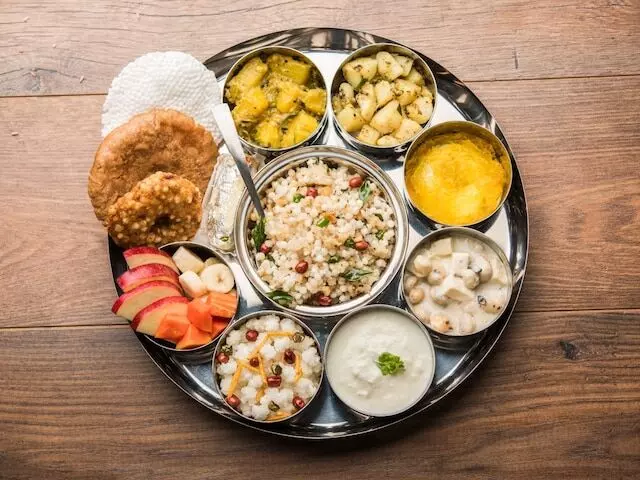Navratri fasting guide: Satvik foods to eat and avoid
Onions and garlic are on the list of foods that must be excluded from a Navratri diet
By Beyniaz Edulji
Hyderabad: Dussehra, also known as Vijayadashami, which marks the end of Navratri, is a Hindu festival celebrated to mark the victory of good over evil. A strict Satvik diet is followed by most people during Navratri or the nine days before Dusshera and many foods are avoided.
Food to avoid
Onions and garlic are on the list of foods that must be excluded from a Navratri diet.
Mushrooms, leeks, green onions and shallots are also avoided. Wheat, rice, refined flour, suji, corn flour and all kinds of legumes and pulses are avoided while fasting. Regular salt, haldi, curry powder, coriander and mustard are not consumed while observing a Navratri fast. Alcohol, eggs and meat are prohibited.
Beena Chimalgi of Begumpet said, “In my household garlic, onions and other vegetables grown below the soil like radish and peanuts are also not eaten. Ghee is used and not oil.”
Significance of Navratri
Sangeeta Dhawan of Sainikpuri told NewsMeter, “The word Navratri means nine nights. We were taught as children that these nights belonged to nine Goddesses. The festival meant nine days of fun, dance, pooja and frolic. I have won many a best dressed or the best dancer prize in dandiya and garba nights for nine nights.
Female worship has always been prominent in Indian culture. Navratri are nine powerful nights dedicated to Devi - a feminine manifestation of the Divine. Even as though various theories are going around, most religious texts agree that it was the demon Mahishasura who was killed by one of the ferocious forms of Goddess Durga. Hence, the victory of Goddess Durga over evil is celebrated during Navratri.”
Sangeeta Dhawan listed the nine days as
Day 1 - Ghatasthapana, Shailaputri Puja
Day 2 - Brahmacharini Puja
Day 3 - Chandraghanta Puja
Day 4 - Kushmanda Puja
Day 5 - Upang Lalita Vrat, Skandamata Puja
Day 6 - Katyayani Puja
Day 7 - Maha Saptami, Kalaratri Puja
Day 8 - Mahashtami, Durgashtami, Kumari Puja, Mahagauri Puja
Day 9 - Maha Navami, Navami Homa, Siddhidatri Puja
“During these days one is not supposed to eat non-vegetarian food. There are people who observe fasts too and abstain from eating grains and non-vegetarian dishes,” she said.
Satvik diet
A Satvik diet is followed by people during Navratri and certain vegetables like garlic, onions, okra, brinjals and mushrooms are avoided during the time irrespective of whether you are observing a fast or not.
People who observe fasts during Navratri can choose from a variety of flours, vegetables, fruits and spices while avoiding wheat, rice, semolina, flour, corn flour, legumes and pulses among others.
Millets, buckwheat flour, sabudana or sago, water chestnut flour, potatoes, sweet potato, bottle gourd, arbi, pumpkin, spinach, bottle gourd, cucumber and carrots are some of the foods that people eat while they are fasting. While some devotees fast on all nine days, others observe fasts in pairs keeping the first two and the last two fasts.
However, it is important to plan meals carefully and try to include various nutrients during Navratri to avoid dehydration and health problems.
Vegetables and fruits
Potatoes, sweet potato, arbi, pumpkin, spinach, bottle gourd, cucumber, carrots and all kinds of fruits like banana, apple, watermelon, papaya and grapes must be included for the mandatory dose of vitamins, minerals and antioxidants. This will ensure good health and immunity during the fast.
Milk
Dairy products and milk can be consumed in a variety of shakes and smoothies.
Those who are diabetic can use natural sugar alternatives like jaggery, honey, dates or stevia. One should try to include curd, yoghurt and buttermilk in their meals as they are excellent probiotics and will prevent digestive troubles while fasting and keep the energy levels high. Ghee is a must during the fast. For protein intake, paneer can be included to keep hunger pangs away.
Flours and rice
Millets, buckwheat flour, sabudana or sago and water chestnut flour can be turned into rotis, pooris and other dishes while fasting.
Salts and spices
One can consume rock salt during Navratri fasting and include spices like cumin, clove and cinnamon. Spices play an important part in controlling cholesterol and blood sugar levels. They also have antioxidant and anti-inflammatory properties and control appetite.
Nuts and dry fruits
A storehouse of proteins, vitamins and minerals, nuts and dry fruits are an important part of the Navratri diet.
Most people include almonds, walnuts, dates, pistachios and raisins while they are fasting to include more nutrition.